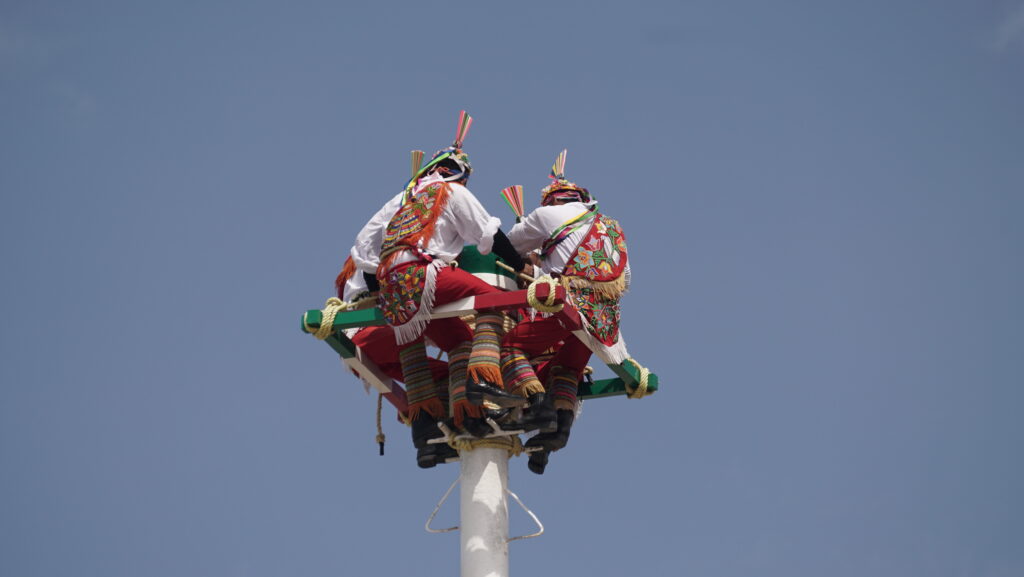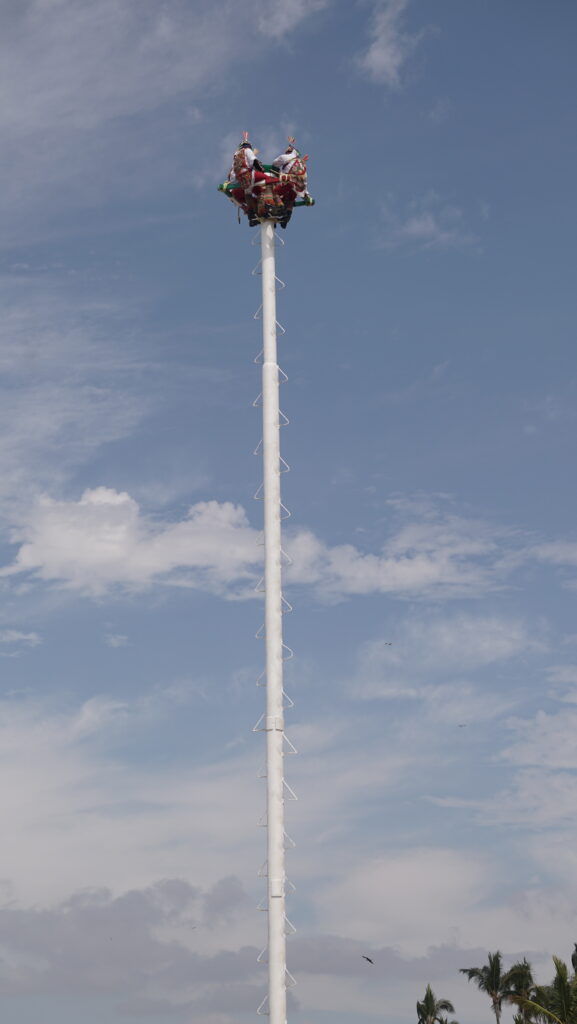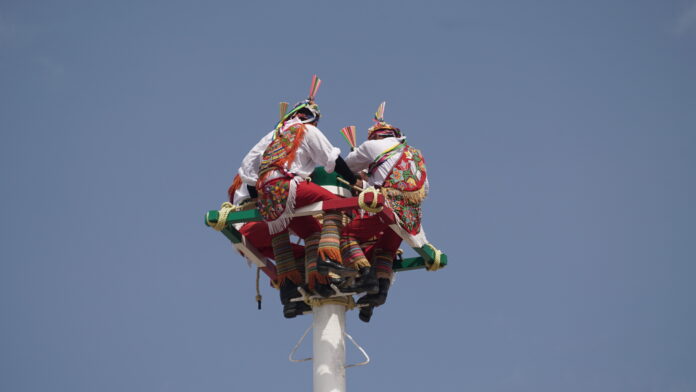What are the Voladores de Papantla? The Danza de los Voladores (Spanish pronunciation: [ˈdansa ðe los βolaˈðoɾes]; “Dance of the Flyers”), or Palo Volador (pronounced [ˈpalo βolaˈðoɾ]; “flying pole”), is an ancient Mesoamerican ceremony/ritual still performed today, albeit in modified form, in isolated pockets in Mexico. It is believed to have originated with the Nahua, Huastec and Otomi peoples in central Mexico, and then spread throughout most of Mesoamerica. The ritual consists of dance and the climbing of a 30-meter (98 ft 5 in) pole from which four of the five participants then launch themselves tied with ropes to descend to the ground. The fifth remains on top of the pole, dancing and playing a flute and drum. According to one myth, the ritual was created to ask the gods to end a severe drought. Although the ritual did not originate with the Totonac people, today it is strongly associated with them, especially those in and around Papantla in the Mexican state of Veracruz. The ceremony was named an Intangible cultural heritage by UNESCO in order to help the ritual survive and thrive in the modern world. The Aztecs believed that Danza de los Voladores was the symbol of their culture.
History
According to Totonac myth, at least 450 years ago [when?] there was a severe drought that brought hunger to the people. The gods were withholding the rain because the people had neglected them. The ceremony was created, to appease the gods and bring back the rains. In some versions of the story, the ritual is created by the old men of a village, who then chose five young men who were chaste. In other versions, the five men themselves create the ritual. The tallest tree in the nearby forest is cut down, with the permission of the mountain god, stripped of branches and dragged to the village. The trunk is erected with much ceremony. The youths climb the pole and four jump off while the fifth played music. The ritual pleased the rain god Xipe Totec and other gods, so the rains began again and the fertility of the earth returned.

The exact origin of this ritual/dance is unknown, but it is thought to have originated with the Huastec, Nahua and Otomi peoples in Sierra de Puebla and mountain areas of Veracruz. The ritual spread through much of the Mesoamerican world until it was practiced from northern Mexico to Nicaragua. Evidence for the ritual stretches back at least as far as the pre-Classic period according to ceramics found in Nayarit. In pre-Hispanic times, the ritual was far more complex, involving taboos and meditation. The participants were thought to impersonate birds and in some areas were dressed as parrots, macaws, quetzals and eagles. These birds represented the gods of the earth, air, fire, and water. By the 16th century, the ritual was strongly associated with solar ceremonies, such as the spring equinox. The ritual is most closely tied with rain and solar deities such as Xipe Totec and Tlazolteotl.

In Maya mythology the creation of the world is associated with a bird deity (Itzamna) residing at the World Tree (the center of the world). Five “birdmen” at the top of a pole represent bird deities. The main dancer stands in the center and plays a flute, which represents the sound of birds singing. The four other “birdmen” (representing the four directions) spin around the pole to represent the recreation of the world (and the regeneration of life) In the early form, instead of only five men there are six men dressed as birds with each member climbing on top and performing a dance and at the end tied ropes around their waist and who all jump in unison and descend downwards. Many villages in Mexico banned this version of the practice due to injuries and even death.

More story here: https://en.wikipedia.org/wiki/Danza_de_los_Voladores
We provide information and resources for visitors to Puerto Vallarta, areas of The Riviera Nayarit and other destinations in both states of Jalisco and Nayarit . You will find variety of content, including articles, blog posts, videos, photos, descriptions and interviews, all of which are designed to help visitors plan their trip, including attractions, restaurants, and events. https://promovisionpv.com/

Visit and Subscribe to our YouTube Channel for more Puerto Vallarta – Riviera Nayarit videos: https://www.youtube.com/@promovision/videos

Web site: https://promovisionpv.com
YouTube: https://youtube.com/promovision
Instagram: https://instagram.com/promovisionpv/
Tweeter: https://x.com/promovisionpv
Threads: https://www.threads.net/@promovisionpv
Facebook: https://facebook.com/ray.dion.73
Blue Sky: https://bsky.app/profile/promovision.bsky.social
Marketing, Turismo Publicitario, Restaurantes, Bienes Raíces, Eventos, Tours, Puerto Vallarta – Riviera Nayarit https://promovisionpv.com/marketing-publicidad-restaurantes-real-estate-events-tours-puerto-vallarta-riviera-nayarit-2/


